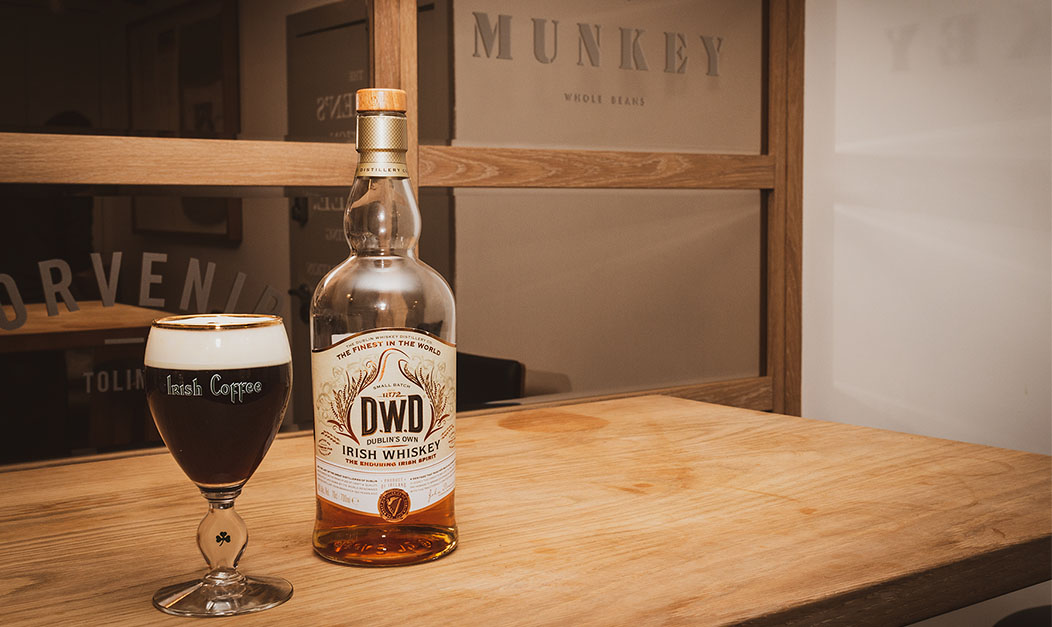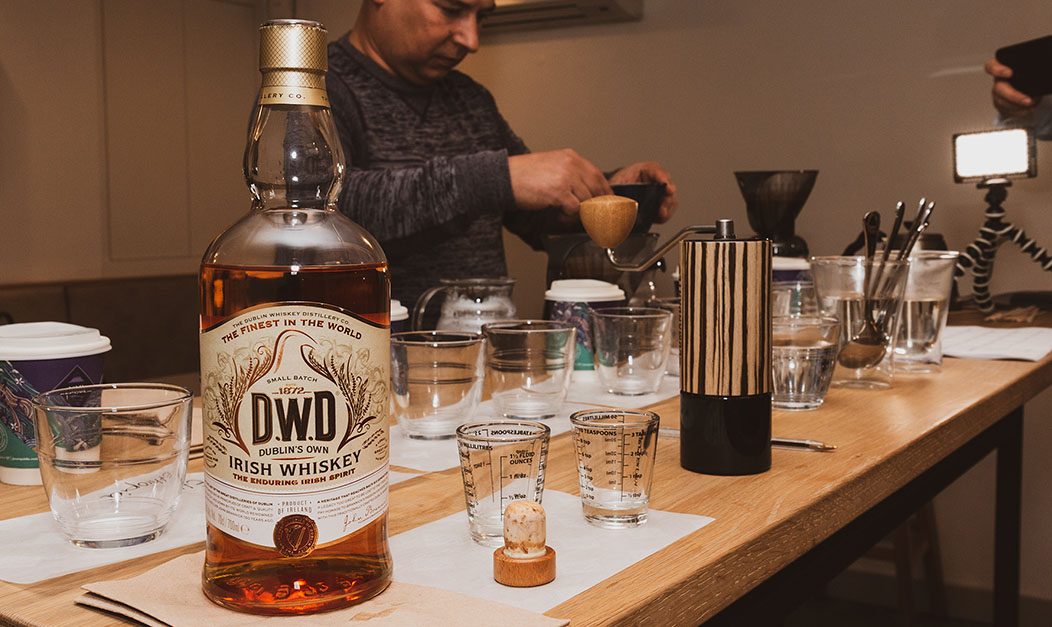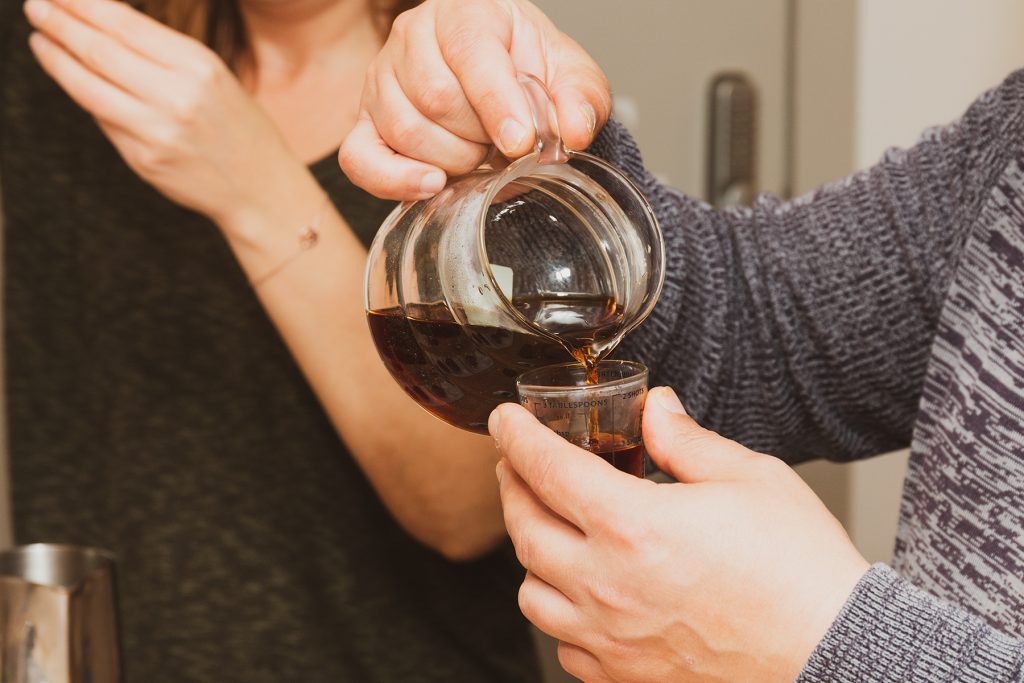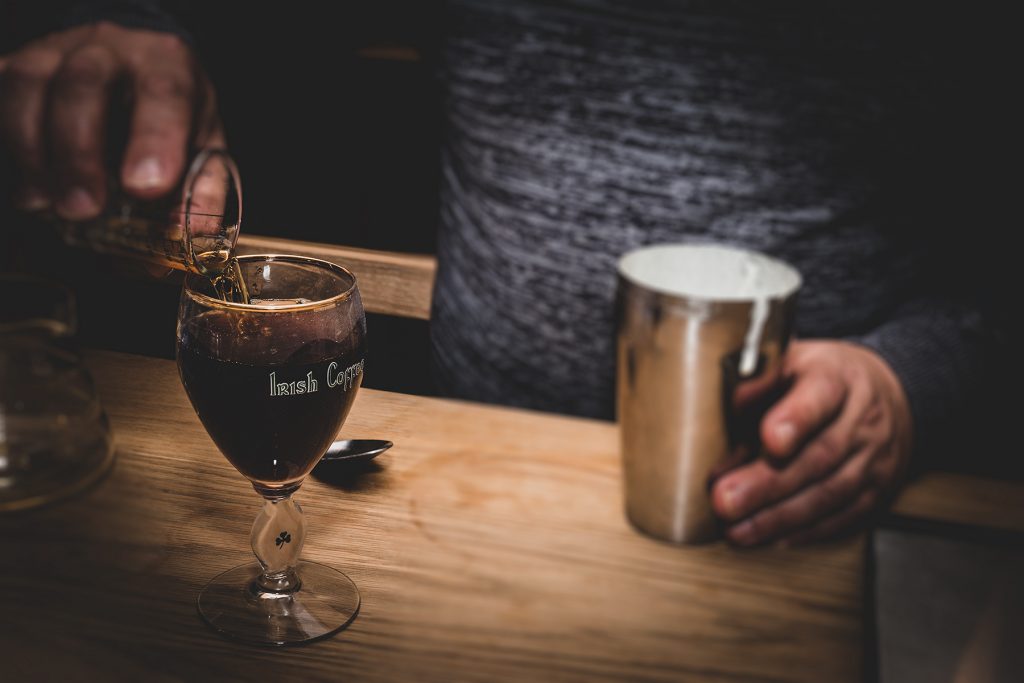Make the perfect Irish Coffee
We’ve reached the pinnacle of our three-part article series, we’ve tried and tested all the different combinations and can finally reveal how to make a perfectly balanced Irish coffee.
One of our Quality Coffee Consultants Renata Malyszko has been continuing her quest to find the perfectly balanced Irish coffee. In part-one of this trilogy of articles on the original coffee cocktail, Renata shared everything she has learned about the history of Irish coffee. In the follow-up article, she shared some of her top tips for making Irish coffee using one coffee and different whiskeys. For the finale, Renata has put another twist on the search for the perfect recipe. Inspired by her unparalleled knowledge of the coffee industry, Renata has taken Irish coffee tasting one step further and researched what happens when you have one whiskey and different coffee origins and processing methods. The outcome from this extensive research is the recipe to beat them all, Renata’s Irish coffee recipe, and, in the interest of complete transparency, a slightly merry group of tasters.
To begin, here are some insights into Renata’s mastermind plan in setting up the Irish coffee tasting. The tasting was broken up into two parts. For part one, Renata and her team of tasters tasted coffees from different origins. For part two the team tested a single origin with different processing methods. All the coffees were tasted firstly on their own and then with the whiskey added. To maintain consistency throughout the coffee was brewed on clever dripper with the same grind size and brew ratio. The coffee and whiskey ratio, 90ml of coffee and 30ml of whiskey, was also the same for every set used in the tasting. All coffees were light roast, washed process and the whiskey used for the tasting was D.W.D.
Part One- Coffee from Different Origins
Here is a summary of the main findings from the tastings for part one:
Peru
Coffee: Tasters experienced notes of nuts (pecans), chocolate, red fruits, cherry. The body was medium to slightly dry, with medium astringent acidity. The sweetness was low, with a nutty long aftertaste.
Coffee and whiskey: When the whiskey was added the nuts and chocolate flavours remained but cherry changes into raspberry. The body increased and dry mouthfeel felt more round, smooth even silky. The acidity decreased and sweetness increased. A long aftertaste remained with notes of nuts.
Nicaragua
Coffee: Tasters experienced notes of nuts (hazelnuts), nougat, red berry, orange, caramel, and toffee. The body was silky-smooth, and acidity was low to medium supported by sweetness. There was a medium smooth aftertaste with notes of peach. Overall the coffee was found to be very well balanced.
Coffee and whiskey: The orange, caramel, toffee, fruity notes, smooth medium body, and acidity were lost completely, however, the sweetness increased. The aftertaste was medium but became unpleasant. Overall the whiskey covered up the nutty character of coffee however fruitiness remained.
Kenya
Coffee: Tasters experienced notes of blackcurrant, blackberry, mix berries, very fruity, citrusy notes. The body was medium smooth and round, with medium acidity supported by the natural sweetness of the coffee. There was a slightly dry aftertaste with blackcurrant skin notes but overall it was well balanced.
Coffee and whiskey: The black fruits changed into red fruits (strawberry, cherry, raspberry). The body has increased and were smoother and more round. The sweetness increased and acidity decreased but it remained well balanced. Overall Kenya origin coffee was well-balanced with the coffee’s character still present.
Colombia
Coffee: Tasters experienced notes of milk chocolate, hazelnuts, orange, apple notes. The body was medium to low, with medium acidity. There was a medium smooth aftertaste and it was very well balanced.
Coffee and whiskey: The chocolaty and nutty character of the coffee remained present but the fruit flavours became more artificial (candy-like raspberries). The acidity lowered with a higher sweetness.
The conclusions drawn from this exercise are; in every case after adding whiskey to coffees the quality of body increased, quality improved to more round and silky, acidity decreased and in some cases was even lost and finally, sweetness increased. It’s worth mentioning that no sugar was used for the tasting. Following part one of tasting, the group were unanimous in agreement that the best choice was the African origins, namely Kenya. The rationale for this decision is that coffee from this origin kept the most natural character and was the most well balanced with the ratio of 90ml of coffee and 30ml of whiskey.
Part Two- Different Coffee Processing Methods
In part two of this tasting experiment, Renata and her team of tasters reviewed different coffee processing methods. Ethiopia origin coffee was used, all light roast but with different processing methods.
Washed process
Coffee: The tasters experienced stone fruits (yellow plum, apricot, peach), pear, apple. The acidity was medium to high, with medium sweetness and a short aftertaste. Overall the coffee was well balanced.
Coffee and whiskey: Adding the whiskey the notes of peach remained but other fruits became more citrusy in character. The body was still low but the quality improved. The acidity remained the same and was well balanced with sweetness. The coffee mellowed with the sharp taste of spirit in whiskey.
Honey process
Coffee: The tasters experienced chocolate, fruits (red grapefruit, black grapes, apricot, ripen peach, plums, cranberries), which they found to be very complex in flavours. The body was medium and smooth, with medium acidity. Overall they found the coffee to be well balanced.
Coffee and whiskey: The complex character of coffee was overpowered by whiskey. The body became rough and dry. Acidity stayed the same, however, sweetness has increased. Overall it was unbalanced due to the overpowering whiskey.
Natural process
Coffee: The tasters experienced tropical dried fruits, pineapple, nuts, prune, dried apple, raisins, spicy (nutmeg). The body of the coffee was full, creamy, with low acidity. The medium sweetness has a long pleasant aftertaste which was well balanced overall.
Coffee and whiskey: The fruity character of coffee developed to caramelly, toffee slightly oaky character. The body remained full, with a long pleasant and sweet aftertaste. Overall the coffee is present but is overpowered by whiskey and subsequently loses its original character.
The conclusions drawn from this exercise highlighted a clear winner. The best choice of coffee was Ethiopia washed, as it kept its fruity character and other sensory attributes. The team of tasters were dramatically underwhelmed by the end result of the Ethiopia honey process as the complex fruity character was lost after adding whiskey. The Ethiopia natural also showed disappointing results as all the flavours were overpowered by whiskey.
Renata’s Irish Coffee Recipe
With all these different tasting tests and outcomes in mind, here is Renata’s recipe for the perfectly balanced Irish coffee:
- 120ml of freshly brewed hot coffee (Kenya or Ethiopia – both washed process; Clever dripper brewing method, 17g of coffee to 230ml of water, total brewing time 3min 30sec)
- 30ml of D.W.D Irish whiskey
- 15ml of light muscovado sugar syrup
- Finished off until the top with lightly whipped cream
- Served in 23cl glass
There you have it, we’ve tried and tested so you don’t have too. It’s worth mentioning that all the above depend on various factors that may affect the taste, for example, the coffee brewing method and extraction time/ variety, processing method, roast profile of coffee, amount and type of sugar used, amount and type of whiskey, type of cream, person’s personal preferences and many more. Therefore, we would always recommend carrying out your own research and tastings to draw your own conclusions and create your own favourite recipes.
Enjoy your Irish coffee and never ever stop experimenting.







You must be logged in to post a comment.